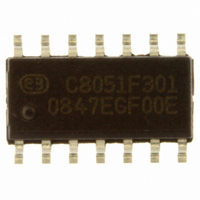C8051F301-GS Silicon Laboratories Inc, C8051F301-GS Datasheet - Page 123

C8051F301-GS
Manufacturer Part Number
C8051F301-GS
Description
IC 8051 MCU 8K FLASH 14-SOIC
Manufacturer
Silicon Laboratories Inc
Series
C8051F30xr
Specifications of C8051F301-GS
Program Memory Type
FLASH
Program Memory Size
8KB (8K x 8)
Package / Case
14-SOIC (3.9mm Width), 14-SOL
Core Processor
8051
Core Size
8-Bit
Speed
25MHz
Connectivity
SMBus (2-Wire/I²C), UART/USART
Peripherals
POR, PWM, WDT
Number Of I /o
8
Ram Size
256 x 8
Voltage - Supply (vcc/vdd)
2.7 V ~ 3.6 V
Oscillator Type
Internal
Operating Temperature
-40°C ~ 85°C
Processor Series
C8051F3x
Core
8051
Data Bus Width
8 bit
Data Ram Size
256 B
Interface Type
I2C/SMBus/UART
Maximum Clock Frequency
25 MHz
Number Of Programmable I/os
8
Number Of Timers
3
Maximum Operating Temperature
+ 85 C
Mounting Style
SMD/SMT
3rd Party Development Tools
PK51, CA51, A51, ULINK2
Development Tools By Supplier
C8051F300DK
Minimum Operating Temperature
- 40 C
Package
14SOIC
Device Core
8051
Family Name
C8051F30x
Maximum Speed
25 MHz
Operating Supply Voltage
3.3 V
Lead Free Status / RoHS Status
Lead free / RoHS Compliant
For Use With
770-1006 - ISP 4PORT FOR SILABS C8051F MCU336-1444 - ADAPTER PROGRAM TOOLSTICK F300336-1319 - REFERENCE DESIGN STEPPER MOTOR
Eeprom Size
-
Data Converters
-
Lead Free Status / Rohs Status
Lead free / RoHS Compliant
Other names
336-1536-5
13.5. SMBus Transfer Modes
The SMBus interface may be configured to operate as master and/or slave. At any particular time, it will be
operating in one of the following four modes: Master Transmitter, Master Receiver, Slave Transmitter, or
Slave Receiver. The SMBus interface enters Master Mode any time a START is generated, and remains in
Master Mode until it loses arbitration or generates a STOP. An SMBus interrupt is generated at the end of
all SMBus byte frames; however, note that the interrupt is generated before the ACK cycle when operating
as a receiver, and after the ACK cycle when operating as a transmitter.
13.5.1. Master Transmitter Mode
Serial data is transmitted on SDA while the serial clock is output on SCL. The SMBus interface generates
the START condition and transmits the first byte containing the address of the target slave and the data
direction bit. In this case the data direction bit (R/W) will be logic 0 (WRITE). The master then transmits
one or more bytes of serial data. After each byte is transmitted, an acknowledge bit is generated by the
slave. The transfer is ended when the STO bit is set and a STOP is generated. Note that the interface will
switch to Master Receiver Mode if SMB0DAT is not written following a Master Transmitter interrupt.
Figure 13.5 shows a typical Master Transmitter sequence. Two transmit data bytes are shown, though any
number of bytes may be transmitted. Notice that the ‘data byte transferred’ interrupts occur after the ACK
cycle in this mode.
Figure 13.5. Typical Master Transmitter Sequence
Interrupt
S
Received by SMBus
Interface
Transmitted by
SMBus Interface
SLA
W
Interrupt
A
Data Byte
Rev. 2.9
Interrupt
A
C8051F300/1/2/3/4/5
S = START
P = STOP
A = ACK
W = WRITE
SLA = Slave Address
Data Byte
Interrupt
A
P
123










